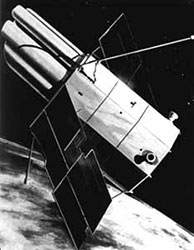Copernicus (OAO-3)
Copernicus (OAO-3)

An artist's conception of the Copernicus (OAO-3) satellite in orbit. (Credit: NASA)
Lifetime: August 1972 - February 1981
Country (primary): United States and United Kingdom
Primary Science
The main instrument on the Copernicus satellite, or the Orbiting Astronomical Observatory 3, was an ultraviolet telescope for cosmic observations.
High Energy Science
In addition to its main ultraviolet telescope, Copernicus carried an X-ray telescope.
Science Highlights
- Discovery of several long-period pulsars
- Long-term monitoring of pulsars and other bright X-ray binaries
- Observed rapid intensity variability in Centaurus A

